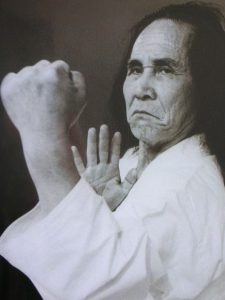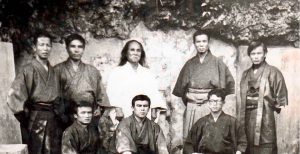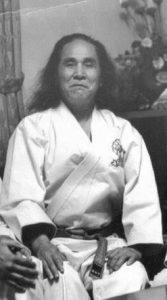Gogen Yamaguchi was crucial in popularizing and developing Goju-ryu in mainland Japan and globally, adding Japanese elements like Taikyoku kata, Jiyu-kumite, and the Goju-kai fist insignia, and establishing the International Karate-do Goju-kai (IKGA).
His charismatic public image and innovative training methods earned him the nickname “The Cat” and helped gain official recognition for Goju-ryu from the Japanese martial arts governing body.


1929 Yamaguchi entered Ritsumeikan University in Kyoto and majored in Law. In 1930 he started the first karate club on the Ritsumeikan campus.
It was during this time jiyu kumite, came into being, which translates as free fighting. Masters of this time stressed kata and were not very big on free sparring as techniques were done in full force and without control.
The system Yamaguchi developed was based on the sparring system of kendo where points are scored for striking specific targets, and eventually would become the basis for modern day tournament fighting.


His agile movements, flowing hair, and charismatic presence attracted significant media attention and earned him the moniker “The Cat”.
Slowly, began the re consolidation the Goju schools that had remained open through the war, while constantly opening new ones.
Following the war focus was on the spread of martial arts and to better himself physically, mentally and spiritually. He sought out Reverend Tadaki Yoshimura, Chief Reverend of Shin-shu Shinto, and eventually became a Shinto master as well.
Yoga tuition was from Tengai Noda, Japan’s leading expert and yoga master at the time. Eventually Yamaguchi would meld these together with his Goju to form his personal system of Goju Shinto.
The face of Goju ryu changed with the influence of Gogen Yamaguchi. Goju-ryu was formally registered and recognized by the Butoku-kai, the governing body for Japanese martial arts.
This is the same organization that awarded him the title of Renshi (senior expert/5th dan) in 1940. In 1950 he founded the Zen Nippon (All Japan) Karate-do Goju-kai, a national organization in Japan.
All karate dojos in Japan were united in 1964 under the Federation of All Japan Karate-do Organization (FAJKO), which is today known as the Japan Karate Federation (JKF).
Following that was his appointed as Shihan (master) of the karate division of the Kokusai Budo Renmei, the International Martial Arts Federation in Japan.
This appointment came from the federation chairman, Prince Higashikuni of the Japanese Imperial Family. Another noteworthy Imperial contact occurred in 1968. when Emperor Hirohito presented Yamaguchi with the Ranju-Hosho (Blue Ribbon Medal) for his contribution to the martial arts.
Even in his late 60’s He founded and opened the Japan Karate-do College in Suginami, a suburb of Tokyo, Japan. This school served as his home as well as the Goju-kai headquarters.
Second floor was a yoga-shinto center for the education and practice of those two arts and the top floor served as a dormitory with accommodations for about 12 students.
Gōgen Yamaguchi visited Sydney and Melbourne in 1970 and 1972.
______________________________________________________________
Gogen sensei had been married twice, firstly to Midori (who still lives on the island of Kyushu), with whom he had four children:
Gōsei Norimi Yamaguchi, Gōsen Kishio Yamaguchi, Makiko Yamaguchi, and Gōshi Hirofumi Yamaguchi.
His second wife, Mitsue, had one child, Gōkyōko Wakako Yamaguchi.
All of his children practiced karate-dō and became Masters in their own right. The names commencing with gō (剛) were their karate names.
Gogen Yamaguchi Sensei died on the 20th of May 1989.
_____________________________________________________________
Contact US via email or call 0828762516